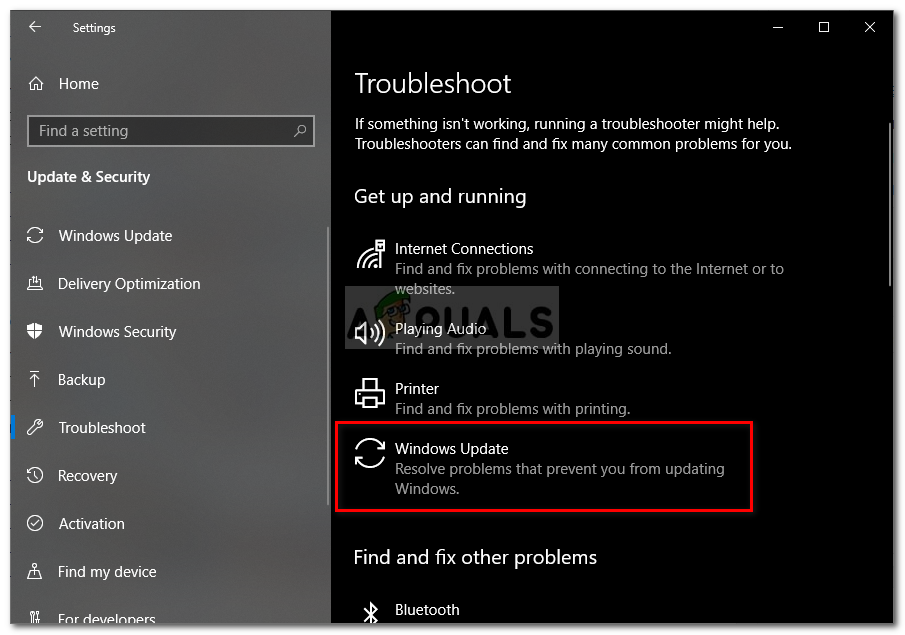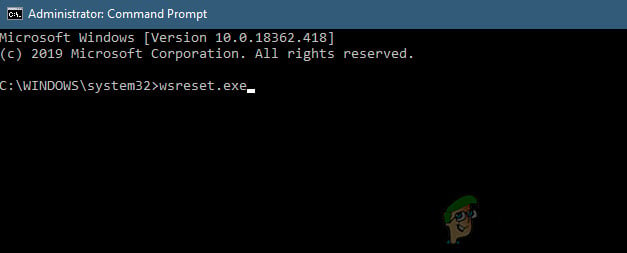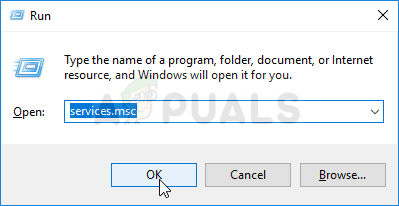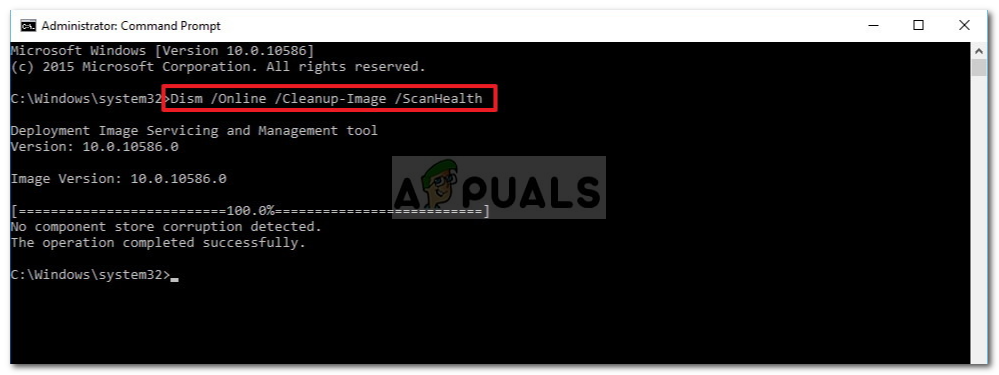How to Fix Windows Update Store Error 0x80D05001
Some Windows 10 users are encountering the 0x80D05001 error code after a Windows Update or Windows Store app update fails to install. The majority of users are seeing this error with every new update that they attempt to install.

There are several potential culprits that might trigger the Error 0x80D05001 with Windows Update or Windows Store:
- Common WU / Store glitch – When troubleshooting for this issue, you should start by attempting to fix the issue automatically with utilities like Windows Update Troubleshooter or Windows Store Troubleshooter.
- Update component inconsistency – If you see this error while attempting to install an update, you should reset the Windows Update / Windows Store component completely (depending on the specifics of your problem.
- Improperly Configured Proxy or VPN – This error code can also occur due to an improperly configured proxy server or VPN client that is being rejected by Windows Update or Windows Store. If this scenario is applicable, you can disable the Proxy server or uninstall your VPN client.
- Overprotective firewall – If you’re using a 3rd party firewall, a certain feature that block pop-ups might also interfere with the Windows Update function. In this case, you will need to disable the real-time protection or uninstall it altogether if the security rules are enforced at a system level.
- Underlying system file corruption – Under certain circumstances, you might be dealing with some type of system corruption that ends up affecting Windows Update or Windows Store. In this case, you can use SFC and DISM scans to identify and fix the corruption problems that are contributing to this issue.
Method 1: Running the Windows Update/ Windows Apps Troubleshooter
If this particular error is being facilitated by a common inconsistency, your first attempt at fixing the issue should be the Windows Update Troubleshooter. This built-in utility holds together a collection of repair strategies that can be automatically applied in case a recognizable scenario is identified.
After you launch this utility, it will begin to scan for common Windows Update inconsistency and recommend a viable repair strategy that you can apply with just several clicks.
Note: In case you are encountering the 0x80D05001 error when attempting to update an app via the built-in Windows Store, you will need to run the Windows Apps Troubleshooter instead.
If you didn’t try this potential fix yet, follow the instructions below to run the Windows Update troubleshooter / Windows Apps Troubleshooter and apply the recommended repair strategy:
- Open up a Run dialog box by pressing Windows key + R. Next, type ‘ms-settings:troubleshoot’ and press Enter to open up the Troubleshooting tab of the Settings app.

Accessing the Activation troubleshooter - Once you’re inside the Troubleshooting tab, scroll down to the Get up and running section click on Windows Update. From the newly appeared context menu, click on Run the troubleshooter.

Running Windows Update Troubleshooter Note: In case you are having issues when updating an app via the Microsoft Store, you need to run the Windows Apps Troubleshooter instead.
- After you launch this utility, wait patiently until the initial scan is complete. If the problem and a viable repair strategy are identified, you will be able to apply the recommended fix by clicking on Apply this fix. If you’re presented with this option, do so and wait for the process to complete.

Apply this fix for Windows Update - Once the repair operation is complete, reboot manually and see if the issue is resolved at the next computer startup by attempting to install an update that was previously failing.
In case the same problem is still occurring, move down to the next potential fix below.
Method 2: Resetting Windows Update / Windows Store
In case the built-in troubleshooter that you deployed above didn’t work for you, it’s likely that you’re seeing the 0x80D05001 error due to an update component inconsistency (especially if you’re seeing this error with every update that you attempt to install).
In most cases, you will see the 0x80D05001 error due to the fact that the updating component is somehow stuck in a limbo state (neither opened or closed). If this scenario is applicable, you should be able to fix the problem swiftly by resetting Windows Update or Windows Store (depending on the specifics of your problem).
To accommodate both potential scenarios, we’ve created 2 separate sub guides. If you’re encountering the issue when installing a Windows update, follow the first guide (A). In case you’re seeing the error when installing an update through Windows Store (Microsoft Store), follow the second guide (B):
A. Resetting Windows Update
- Press Windows key + R to open up a Run dialog box. Next, type ‘cmd’ and press Ctrl + Shift + Enter to open up an elevated Command Prompt window.

Running Command Prompt with admin access Note: Once you are prompted by the UAC (User Account Control), click Yes to grant admin access.
- Once you’re inside an elevated CMD window, type the following commands in whichever order and press Enter after each one:
net stop wuauserv net stop cryptSvc net stop bits net stop msiserver
Note: This set of commands will stop all the relevant Windows Update services from running: BITS service, Cryptographic service, MSI Installer service, Windows update service (main).
- After you manage to stop every relevant service, run the following commands in order to clear and rename two vital WU folders (SoftwareDistribution and Catroot2):
ren C:\Windows\SoftwareDistribution SoftwareDistribution.old ren C:\Windows\System32\catroot2 Catroot2.old
Note: SoftwareDistribution and Catroot are the two main folders responsible for holding and maintaining Windows Update files. Since you can’t really delete them conventionally, the best way to ensure that they don’t have any corrupted files that might contribute to this error is to rename them in order to force your OS to create new and healthy equivalents.
- Once the two folders have been renamed, run the following commands in order to re-enable the services that you previously disabled (at step 2):
net start wuauserv net start cryptSvc net start bits net start msiserver
- Once every relevant service has been restarted, repeat the WU action that was previously triggering the 0x80D05001 error and see if the problem is now fixed.
B. Resetting Windows Store
- Open up a Run dialog box by pressing Windows key + R. Next, type ‘cmd’ inside the text box and press Ctrl + Shift + Enter to open up an elevated Command Prompt window. When you see the User Account Control (UAC) prompt, click Yes to grant admin access.

Running the Command Prompt - Inside the elevated Command Prompt, type the following command and press Enter to initiate a complete Windows Store reset (and also clear any associated dependencies):
wsreset.exe

Resetting Windows Store - After the operation is complete, attempt to install the app update once again and see if the problem is now fixed.
In case you’ve already reset Windows Update or Windows Store and you’re still seeing the same error message, move down to the next potential fix below.
Method 3: Disable Proxy or VPN client (if applicable)
This particular error code is often an underlying sign that you are dealing with an improperly configured proxy server or VPN client that is being rejected by Windows Update. Due to security reasons, Windows Update might decide to distrust the VPN / Proxy connection and block communications with it.
Several affected users that have previously dealt with this problem have confirmed that they managed to fix the issue after they disabled their VPN Client or Proxy server.
If this scenario is applicable, follow one of the two sub-guides bellows to get rid of the VPN client you’re currently using or disable the Proxy server that’s currently active:
A. Disable Proxy Server on Windows
- Press Windows key + R to open up a Run dialog box. Inside the newly appeared Run box, type ‘ms-settings:network-proxy’ and press Enter to open up the Proxy tab of the Settings menu.

Running Services in the Run dialog box - Once you’re inside the Proxy tab of the Settings menu, scroll all the way down to the Manual proxy setup. When you get there, simply disable the toggle associated with Use a proxy server.

Disabling the use of a proxy server - Once you complete this modification, reboot your computer and repeat the action that was previously causing the 0x80D05001 error.
B. Uninstall VPN client on Windows
- Open up a Run dialog box by pressing Windows key + R. Next, type ‘appwiz.cpl’ and hit Enter to open up the Programs and Features menu.

Type appwiz.cpl and Press Enter to Open Installed Programs List - Once you’re inside the Programs and Features screen, scroll down through the list of installed applications and locate the VPN client that you’re looking to uninstall.
- After you manage to identify your VPN client, right-click on it and choose Uninstall from the newly appeared context menu.

Uninstalling a VPN tool - Once you’re inside the uninstallation window, follow the on-screen prompts to complete the process, then restart your computer.
- After the process is complete, restart your computer and see if the 0x80D05001 error is resolved.
In case this potential fix is not applicable to your particular scenario, move down to the next potential fix below.
Method 4: Disable Overprotective Firewall (if applicable)
As some affected users have confirmed, the 0x80D05001 error can also be facilitated by an overprotective firewall function. For example, certain 3rd party firewalls have a security suite that blocks pop-ups. Well, as it turns out, this function can also end up blocking the Updating function on Windows 10.
In case you’re using a 3rd party firewall that you suspect might be responsible, you should start by attempting to disable the real-time protection before repeating the updating operation. In most cases, AV suites will allow you to do this directly from the taskbar icon.

Once you’ve disabled your firewall, attempt to perform the update again and see if the issue is resolved.
If that didn’t work, keep in mind that some firewalls enforce restrictions at a network level and often enough, these security rules will remain in place even if the real-time protection is disabled. Because of this, you should also try uninstalling your firewall and removing any remnant files before ruling this potential culprit out.
In case this scenario is not applicable or you’ve already done this and you’re still seeing the 0x80D05001 error, move down to the final fix below.
Method 5: Running SFC and DISM scans
If none of the fixes detailed above have worked for you, there’s a high chance that the problem is actually being facilitated by some type of system file corruption that ends up affecting the Windows Update or Windows Store component.
If this is your culprit, you should be able to fix the issue by initiating an SFC scan and wait patiently until the process is complete. But keep in mind that once you start this process, forcibly closing the CMD window might produce additional logical errors.

After this SFC scan is complete, reboot your machine and see if the issue is fixed. In case you’re still encountering the 0x80D05001 error, advance with initiating a DISM scan.






